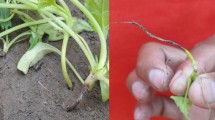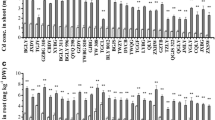Abstract
Loessal soil is one of the main cultivated soils in northwest China. Part of its distribution area was irrigated with industrial wastewater in past three decades. This caused heavy metal contamination in the soil. It had induced toxicity on crops and also threatened local human health for now. Based on a field plot experiment, effects of different Cu concentrations (from 45 to 2000 mg kg−1) in loessal soil on spinach plant growth and uptake of mineral nutrients (Zn, Fe, Mg, K, and Ca) by spinach were investigated. The Cu addition increased available concentrations of mineral nutrients in loessal soil and concentrations of Cu, Zn, Mg, and Ca in roots. The translocation of mineral nutrients from roots to leaves was inhibited under Cu addition, inducing their decrease in leaves. The EC10 and EC50 of soil Cu in relative dry weights of leaves were 240.33 mg kg−1 and 1205.04 mg kg−1, respectively. The PLS-PM analysis showed that available concentrations of nutrients in soil were only affected by Cu in soil positively, nutrients in roots were mainly affected by Cu in soil and Cu in leaves positively, nutrients in leaves were mainly affected by Cu in roots negatively, translocation of nutrients in spinach and plant growth were principally affected by Cu in leaves negatively, and the total effect of Cu in leaves on nutrients in roots and leaves, translocation of nutrients in spinach, and plant growth was the highest. Our results indicated that the phytotoxicity of Cu including spinach growth inhibition and mineral disorder in spinach was mainly affected by the Cu concentrations in leaves.




Similar content being viewed by others
Data Availability
The datasets used and/or analyzed during the current study are available from the corresponding author on reasonable request.
References
Agarwal K, Sharma A, Talukder G (1989) Effects of copper on mammalian cell components. Chem Biol Interact 69:1–16
Ambrosini VG, Rosa DJ, Melo GWB, Zalamena J, Cella C, Simao DG, Silva LS, Santos HP, Toselli M, Tiecher TL, Brunetto G (2018) High copper content in vineyard soils promotes modifications in photosynthetic parameters and morphological changes in the root system of ‘Red Niagara’plantlets. Plant Physiol Biochem 128:89–98
Brun L, Le Corff J, Maillet J (2003) Effects of elevated soil copper on phenology, growth and reproduction of five ruderal plant species. Environ Pollut 122:361–368
Calabrese EJ (1999) Evidence that hormesis represents an “overcompensation” response to a disruption in homeostasis. Ecotoxicol Environ Saf 42:135–137
Cheng H, Tam NF-Y, Wang Y, Li S, Chen G, Ye Z (2012) Effects of copper on growth, radial oxygen loss and root permeability of seedlings of the mangroves Bruguiera gymnorrhiza and Rhizophora stylosa. Plant Soil 359:255–266
Chandrasekhar C, Ray JG (2017) Copper accumulation, localization and antioxidant response in Eclipta alba L. in relation to quantitative variation of the metal in soil. Acta Physiol Plant 39:205–219
Da Silva JF, Williams RJP (2001) The biological chemistry of the elements: the inorganic chemistry of life. Oxford University Press, Oxford
De Vos C, Schat H, De Waal M, Vooijs R, Ernst W (1991) Increased resistance to copper-induced damage of the root cell plasmalemma in copper tolerant Silene cucubalus. Physiol Plant 82:523–528
Deluisa A, Giandon P, Aichner M, Bortolami P, Bruna L, Lupetti A, Nardelli F, Stringari G (1996) Copper pollution in Italian vineyard soils. Commun Soil Sci Plant Anal 27:1537–1548
Dhillon S, Sidhu P, Sinha M (1981) Copper adsorption by alkaline soils. J Soil Sci 32:571–578
Dong G, Jackson NN, Hong ZN, Dong Y, Lu HL, Yang J, Pan XY, Xu RK (2020) Phytotoxicity of Cu2+ and Cd2+ to the roots of four different wheat cultivars as related to charge properties and chemical forms of the metals on whole plant roots. Ecotox Environ Safe 196:1–9
Duan C, Razavi BS, Shen G, Cui Y, Ju W, Li S, Fang L (2019) Deciphering the rhizobium inoculation effect on spatial distribution of phosphatase activity in the rhizosphere of alfalfa under copper stress. Soil Biol Biochem 137:1–10
EPA (1996) Acid digestion of sediments, sludges and soils (Revision 2) (method 3050b). United States Environmental Protection Agency, Washington DC
Evans RC (1966) An introduction to crystal chemistry. Cambridge University Press, Cambridge
Gardea-Torresdey J, Peralta-Videa J, Montes M, De la Rosa G, Corral-Diaz B (2004) Bioaccumulation of cadmium, chromium and copper by Convolvulus arvensis L.: impact on plant growth and uptake of nutritional elements. Bioresour Technol 92:229–235
Huo K, Shangguan X, Xia Y, Shen Z, Chen C (2020) Excess copper inhibits the growth of rice seedlings by decreasing uptake of nitrate. Ecotox Environ Safe 190:1–9
Jalali M, Moharrami S (2007) Competitive adsorption of trace elements in calcareous soils of western Iran. Geoderma 140:156–163
Kabata-Pendias A (2000) Trace elements in soils and plants. CRC press, New York
Kader M, Lamb DT, Wang L, Megharaj M, Naidu R (2016a) Predicting copper phytotoxicity based on pore-water pCu. Ecotoxicology 25:481–490
Kader M, Lamb DT, Mahbub KR, Megharaj M, Naidu R (2016b) Predicting plant uptake and toxicity of lead (Pb) in long-term contaminated soils from derived transfer functions. Environ Sci Pollut Res 23:15460–15470
Kader M, Lamb DT, Wang L, Megharaj M, Naidu R (2018) Copper interactions on arsenic bioavailability and phytotoxicity in soil. Ecotox Environ Safe 148:738–746
Kirkham M (2006) Cadmium in plants on polluted soils: effects of soil factors, hyperaccumulation, and amendments. Geoderma 137:19–32
Lidon FC, Henriques FS (1993) Effects of copper toxicity on growth and the uptake and translocation of metals in rice plants. J Plant Nutr 16:1449–1464
Luo Y, Rimmer DL (1995) Zinc-copper interaction affecting plant growth on a metal-contaminated soil. Environ Pollut 88:79–83
Mapanda F, Mangwayana E, Nyamangara J, Giller K (2007) Uptake of heavy metals by vegetables irrigated using wastewater and the subsequent risks in Harare, Zimbabwe. Phy chem earth parts A/B/C 32:1399–1405
Marschner P (2011) Marschner’s mineral nutrition of higher plants. Elsevier Academic Press, San Diego
McBride MB (1994) Environmental Chemistry of Soils. Oxford University Press, Oxford
MEE and SAMER (2018) Soil environmental quality一risk control standard for soil contamination of agricultural land (GB15618-2018). Chinese Standards Press, Beijing
Meharg AA (1993) The role of the plasmalemma in metal tolerance in angiosperms. Physiol Plant 88:191–198
Merlos MA, Zitka O, Vojtech A, Azcon-Aguilar C, Ferrol N (2016) The arbuscular mycorrhizal fungus Rhizophagus irregularis differentially regulates the copper response of two maize cultivars differing in copper tolerance. Plant Sci 253:68–76
MOA (1988) Method for determination of soil carbonate (NY/T 86–1988). China Agriculture Press, Beijing
MOA (2006a) Soil testing Part 3: Method for determination of soil mechanical composition (NY/T 1121.3-2006). China Agriculture Press, Beijing
MOA (2006b) Soil testing Part 2: Method for determination of soil pH (NY/T 1121.2-2006). China Agriculture Press, Beijing
Molina M, Manquian-Cerda K, Escudey M (2010) Sorption and selectivity sequences of Cd, Cu, Ni, Pb, and Zn in single-and multi-component systems in a cultivated Chilean Mollisol. Soil Sed Contamin 19:405–418
Muccifora S (2008) Effects of copper on spore germination, growth and ultrastructure of Polypodium cambricum L. gametophytes. Environ Pollut 153(2):369–375
Nan Z, Zhao Z, Liu X, Saha UK, Ma LQ, Clarkesather AR, Zhao Z (2010) The uptake and translocation of selected elements by cole (Brassica) grown using oasis soils in pot experiments. Toxicol Environ Chem Rev 92:1541–1549
Nelson DW, Sommers LE (1996) Methods of soil analysis part 3—chemical methods (methods of soil an3) Total carbon, organic carbon, and organic matter. Soil cience Society of Amireca and American Society of Agronomy, Madison.
Ondo J, Prudent P, Menye Biyogo R, Domeizel M, Vassalo L, Eba F (2012) Effects of Cu and Zn supplementation on metal uptake by Hibiscus sabdariffa Research. J Chem Sci 2(11):45–50
Ouzounidou G, Čiamporová M, Moustakas M, Karataglis S (1995) Responses of maize (Zea mays L.) plants to copper stress—I. Growth, mineral content and ultrastructure of roots. Environ Exp Bot 35:167–176
Paschke MW, Redente EF (2002) Copper toxicity thresholds for important restoration grass species of the Western United States. Environ Toxicol Chem 21:2692–2697
Pautler MC, Sims JT (2000) Relationships between soil test phosphorus, soluble phosphorus, and phosphorus saturation in Delaware soils. Soil Sci Soc Am J 64:765–773
Qu C, Shi W, Guo J, Fang B, Wang S, Giesy JP, Holm PE (2016) China’s soil pollution control: choices and challenges. Environ Sci Technol 50:13181–13183
Rachou J, Sauvé S (2008) Evaluation of affinity constants of Cu, Cd, Ca and H for active soil surfaces for a solid phase-controlled soil ligand model. Environ Chem 5:150–160
Reckova S, Tuma J, Dobrev P, Vankova R (2019) Influence of copper on hormone content and selected morphological, physiological and biochemical parameters of hydroponically grown Zea mays plants. Plant Growth Regul 89:191–201
Salim R, Al-Subu M, Isa M (1995) Effect of root-treatment of cauliflower, parsley and spinach plants with copper and zinc on the plant-growth. J Environ Sci Health Part A 30:2123–2132
Sarwar N, Malhi SS, Zia MH, Naeem A, Bibi S, Farid G (2010) Role of mineral nutrition in minimizing cadmium accumulation by plants. J Sci Food Agric 90:925–937
Strange J, Macnair MR (1991) Evidence for a role for the cell membrane in copper tolerance of Mimulus guttatus Fischer ex DC. New Phytol 119:383–388
Tu C, Zheng C, Chen H (2000) Effect of heavy metal pollution on potassium behavior in Typic Udic Ferrisol. Pedosphere 10:21–30
Vázquez S, Goldsbrough P, Carpena RO (2006) Assessing the relative contributions of phytochelatins and the cell wall to cadmium resistance in white lupin. Physiol Plant 128:487–495
Vega F, Covelo E, Andrade M (2009) Hysteresis in the individual and competitive sorption of cadmium, copper, and lead by various soil horizons. J Colloid Interface Sci 331:312–317
Vinzi VE, Chin WW, Henseler J, Wang H (2010) Handbook of partial least squares: concepts, methods and applications. Springer-Verlag, Berlin Heidelberg,
Yruela I (2009) Copper in plants: acquisition, transport and interactions. Funct Plant Biol 36:409–430
Yu S, He Z, Huang C, Chen G, Calvert D (2002) Adsorption–desorption behavior of copper at contaminated levels in red soils from China. J Environ Qual 31:1129–1136
Yuan G, Lavkulich L (1997) Sorption behavior of copper, zinc, and cadmium in response to simulated changes in soil properties. Commun Soil Sci Plant Anal 28:571–587
Zeng Q, Ling Q, Wu J, Yang Z, Liu R, Qi Y (2019) Excess copper-induced changes in antioxidative enzyme activity, mineral nutrient uptake and translocation in sugarcane seedlings. B Environl Contam Toxicol 103:834–840
Acknowledgements
The authors are grateful for cooperation of Lanzhou Meteorological Administration, as well as Xicheng Liu and Junming Bai for assistance with field management of spinach growth.
Funding
This work was supported by the PhD scientific research start-up capital of Lanzhou City University (LZCU-BS2018-15), Gansu Natural Science Foundation (18JR3RA220), and Open fund project of Kay Laboratory of Polymer Materials of Ministry of Education of Ecological Environment (KF-18-04).
Author information
Authors and Affiliations
Contributions
Zheng Liu: Conceptualization; Data curation, Formal analysis, Funding acquisition, Investigation, Methodology, Project administration, Writing-original draft, Writing-review and editing. Ying Bai: Data curation, Formal analysis, Investigation. Lixia Luo: Data curation, Investigation. Jundi Wan: Data curation, Investigation. Wei Wang: Data curation, Investigation. Guohu Zhao: Funding acquisition, Investigation.
Corresponding author
Ethics declarations
Ethics approval and consent to participate
Not applicable.
Consent for publication
Not applicable.
Competing interests
The authors declare that they have no competing interests.
Additional information
Responsible Editor: Elena Maestri
Publisher’s note
Springer Nature remains neutral with regard to jurisdictional claims in published maps and institutional affiliations.
Rights and permissions
About this article
Cite this article
Liu, Z., Bai, Y., Luo, L. et al. Effects of high dose copper on plant growth and mineral nutrient (Zn, Fe, Mg, K, Ca) uptake in spinach. Environ Sci Pollut Res 28, 37471–37481 (2021). https://doi.org/10.1007/s11356-021-13395-7
Received:
Accepted:
Published:
Issue Date:
DOI: https://doi.org/10.1007/s11356-021-13395-7




